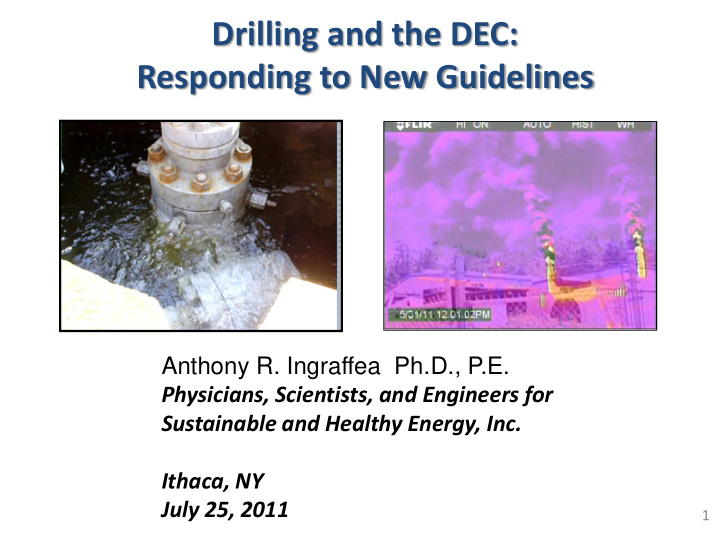



Drilling and the DEC: Responding to New Guidelines Anthony R. Ingraffea Ph.D., P.E. Physicians, Scientists, and Engineers for Sustainable and Healthy Energy, Inc. Ithaca, NY July 25, 2011 1
Purpose of An Environmental Impact Statement Identify Potential Impacts Assess Identified Impacts Propose Propose Mitigation of Prohibition of Identified Impacts Identified Impacts “The DEC proposes to require, via permit condition and/or regulation , that for High Volume Hydraulic Fracturing (HVHF)…… 2
Focus Tonight on Only Two Potential Impacts and Proposed Actions See Table 11.1 for Roadmap to Impacts and Proposed Actions 3
6.6 Greenhouse Gas Emissions: GWP Factors And Time Horizon “Chesapeake Energy Corporation’s July 2009 Fact Sheet on gas emissions states that CO2 has a GWP of 1 and CH4 has a GWP of 23 , and that this comparison allows emissions of greenhouse gases to be estimated and reported on an equal basis as CO2e. However, GWP factors are continually being updated, and for the purpose of this analysis as required by the Department ‟ s 2009 Guide for Assessing Energy Use and Greenhouse Gas Emissions in an Environmental Impact Statement, the 100-Year GWP factors … were used to determine total GHGs as CO2e.” Page 6-197 4
6.6 Greenhouse Gas Emissions: GWP Factors And Time Horizon SGEIS ignores much more recent research on GWP’s and difference between HVHF and wells in methane emissions, e.g. Howarth et al . 2011, wherein 100 Year GWP of CH 4 is 33 and 20 Year GWP is 105 5
6
Marcellus Well Being “Finished” Outside Dimock, Pa June, 2011: Major Source of Methane Emission 7 Photo and FLIR Video Courtesy Frank Finan
Compressor Station in PA Under Standard and Infrared Photography: Major Source of Methane Emission as GHG Video Courtesy of the CHESEPEAKE BAY FOUNDATION 8
Bubbling in Muncy Creek, Lycoming County, PA: Example of Migration of Methane as GHG Video Courtesy of Ralph Kisberg, Responsible Drilling Alliance 9
Identification of Impact and Proposed Mitigations: Table 11.1 10
Identification of Impact and Proposed Mitigations 11
Methane Migration to Well Head, Dimock, PA: Major Source of Methane Emission and Indication of Possible Water Well Contamination 12
The “New” Intermediate Casing Myth Additional Well Casing to Prevent Gas Migration: In most cases, an additional third, cemented well casing is required around each well to prevent the migration of gas. The three required casings are the surface casing, the new intermediate casing and the production casing. The depths of both surface and intermediate casings will be determined by site-specific conditions. 13
As-Built Casing Layouts for 2 PA Marcellus Wells That Contaminated Water Wells 14
15
Sustained Casing Pressure and Gas Migration Are Chronic Problems Brufatto et al., Schlumberger OilField Review, Autumn, 2003. 16
Sustained Casing Pressure and Gas Migration Are Chronic Problems Watson and Bachu, SPE 106817, 2009. 17
18
What DEC Did NOT Report from What Was Learned in PA The suggested, required addition of an INTERMEDIATE, “PROTECTIVE” layer of casing, does NOT prevent methane or other fluid migration. The SGEIS does not contain a statistical analysis from the experience of 3500+ PA Marcellus wells of: • Incidents of fluid migration. e.g. # of confirmed well water contaminations • Incidents of blowouts, pipeline failures, pad fires, etc. • Methane emissions, vented and fugitive • Flowback , “produced water”, and brine waste volumes • Liquid and solid waste final disposition • Citations and enforcements 19
Thank You for Attending and Participating Tonight 20
Recommend
More recommend